
NCH-40

R. F. Dale, Purdue University E. A. Runge, Texas A & M University D. G. Hanway, Univ. of Nebraska-Lincoln R. M. Castleberry, Dekalb-Pfizer Genetics, IL R. E. Carlson, Iowa State University M. W. Seeley, University of Minnesota G. 0. Benson, Iowa State University R. H. Shaw, Iowa State University R. E. Felch, Control Data Corporation, MN D. R. Hicks, University of Minnesota C. M. Sakamoto, Center for Energy & Ag Assessment, MO R. L. Nielsen, Purdue University
In the simplest terms, a crop growing season refers to that period of the year when seasonal weather is favorable for growth. In the Corn Belt, the "growing season" is often defined as the number of freeze-free days during the year beginning with the last freezing temperature in the spring and ending with the first occurrence of freezing temperatures in the autumn. This definition makes good physical sense because of its relationship to the freezing temperature for water-the most universal compound in living plants. It is also closely related to the normal corn crop growing season across the U.S, Corn Belt.
The average spring planting date within the Corn Belt is rather closely related to the average date of the last spring freeze for most areas. Adapted full-season hybrids at any location must reach maturity under normal seasonal weather Conditions, by the average first autumn freeze. In the major portion of Corn Belt, proper full-season hybrids are adapted rather closely to the average frost-free season. For the most southern areas of the Corn Belt and further south, full-season hybrids are adapted to reach maturity in about five months or 150 days. In these geographic areas, the frost- free season is much longer than the corn crop growing season; and because of this, the corn crop growing season is not determined by the freeze-free season.
Across the central Corn Belt, most commercial hybrids are adapted to mature in 130 to 150 days; in the northern portions of the Corn Belt, commercial grain hybrids are adapted to mature in four months, or about 120 days, under normal growing-season weather conditions. In fact, the northern limit of the U.S. Corn Belt, where corn is grown as a grain crop, relates rather closely to the average frost-free growing season of 120 days.
Corn can survive brief exposures to adverse temperatures, such as temperatures ranging from near 32 F (0 C) to over 112 F (45 C). The growth limits are somewhat less, with beginning temperatures of near 41 F (5 F ) climbing to near 95 F (35 C). Optimal temperatures for growth vary between day and night, as well as over the entire growing season; for example, during daylight hours, the optimal ranges between 77 F and 91 F (25-33 C) while night temperatures range between 62 F and 74 F (17-23 C). However, the optimal average temperatures for the entire crop growing season ranges between 68 F to 73 F (20-22 C). These relationships are illustrated in Figure 1.
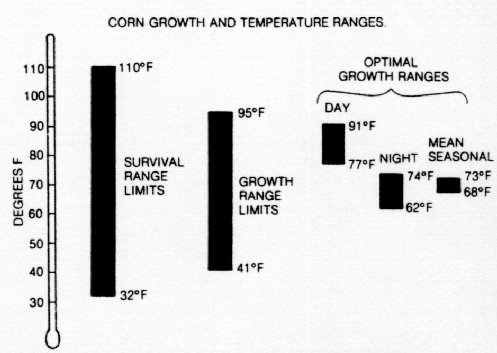
Corn will germinate and grow slowly at about 50 F (10 C), but the average first spring planting dates across the U.S. usually begin when the average air temperatures reach 55 F (13 C) and soil temperature at seed depth is favorable for seedling growth. Poor germination resulting from below-normal temperatures rather than freezing temperatures is the greatest hazard of planting too early. The most common stress imposed at this time is that of cold soil temperatures. The growing point of germinating seedlings remains below the soil surface and they are not vulnerable until several days after the emergence. By this time, the probability of freezing temperatures has greatly decreased. High-temperature stress during ear formation, reproduction, and grainfill is normally detrimental to yield. Under rain-fed conditions, corn usually begins to stress when air temperatures exceed 90 F (32 C) during the tasseling-silking and grainfill stages. Data from Nebraska showed the yield of dryland corn may be reduced 1 1/2 bushel per acre for each day the temperature reaches 95 F (35 C), or higher, during this critical period.
Historically, the number of days from planting to harvest has been used to classify the maturity of corn hybrid; but in recent years, commercial corn hybrid maturity is often determined by growing - degree days (GDD) or heat units (Hu). Growing-degree days are systems used to classify the maturity of corn hybrids. GDD result from summation of mean daily temperature.
The GDD concept assumes that:
A base temperature of 40 F (5 C) is commonly used for cool-season crops such as wheat, oats, and canning peas while a higher temperature of 50 F (10 C) is used for warm-season crops such as field corn, sorghum, and sweet corn. The GDD are determined by subtracting the base temperature from the daily average temperature. For example, the average daily temperature in central Iowa at Des Moines on May 1, when corn is planted, is 56 F; therefore, a 56-50 (degree representation) = 6 GDD. On July 4 when the average temperature is warmer, 74 F, there would be a 74-50 (degree representation) = 24 GDD. In terms of degree days, the rate of corn growth on July 4 would be 24 and when divided by 6, it would be four times as great as at the cooler temperature on May 1. A classification of hybrids for the central part of the Corn Belt representing days from planting to harvest and GDD is presented in Table 1.
Maturity Days GDD --------------------------------------- Early-season 85-100 2100-2400 Mid-season 101-130 2400-2800 Full-season 131-145 2900-3200
The average mid-season commercial corn hybrid in the central Corn Belt requires about 130 days from planting to maturity, or 2700 GDD. A hybrid of this type requires about 70 days from planting to mid-silk flowering, or 1400 GDD. If planted by mid-May under normal seasonal temperatures, such a hybrid will reach black-lay maturity by mid-September. For the central Corn Belt at Lafayette, Indiana, the relationships for a mid-season hybrid growth and maturity for the central Corn Belt at Lafayette are illustrated in Figure 2.
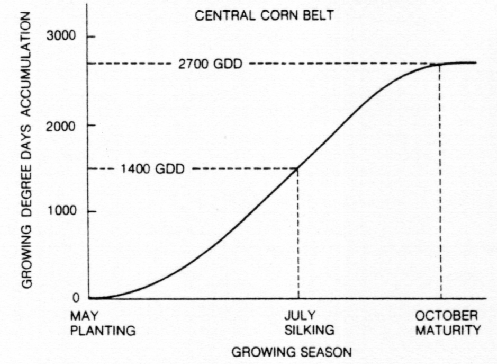
The mean GDD values for the Corn Belt and adjacent regions are illustrated in Figure 3. Over a five-month period of May 10 to October 10, the northern boundary of corn grown for grain receives an average of 2400 GDD. The southern boundary receives an average of 3600 GDD. The GDD values in Figure 3 are compiled by the "cut-off" method.
The calculation procedure of the cut-off method assumes that the maximum sustainable corn growth rate is 86 F (30 C). This assumes that higher temperatures do not sustain faster growth rates. So, all daily maximum temperatures above 86 F (30 C) are set to 86 F (30 C) for ODD calculation purposes; and if the daily mean temperature is greater than the "base temperature" for corn of 50 F (10 C) and the daily minimum is below 50 F (10 C), then the daily minimum is set at 50 F (10 C) to calculate the ODD value on such a day.
The mean daily temperature cut-off method assumes that maize begins to grow at 100C, which is define as the "base" temperature. The maximum growth rate, sustained over a 24-hour period, is assumed to be near 300 C. Further, it is assumed that higher daily mean temperatures do not lead to faster growth rates. Therefore, the ODD value for each day is calculated as:
GDD = Tmax x Tmin - Tbase
-----------
2
where Tmax is set equal to 30 C, (86 F),
when it exceeds 30C (86 F)
Tmin 10 C is set at 10 C, and
Tbase= 10 C.
In this manner, Tmax will always be entered as
30 C or less and Tmin will always be entered
as 10 C (50 F), when less than 10 C (50 F).
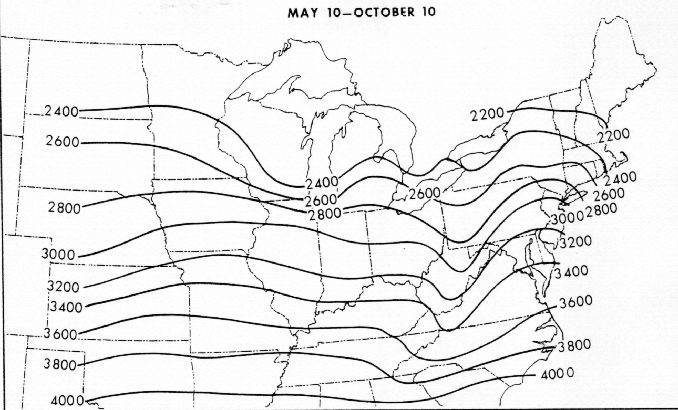
By assuming an average of 10 C diurnal change in temperature, this cut-off method produces a stepwise linear simulation of the maize crop temperature dependent response between 5 C and 35 C, as shown in Figure 4, the linear relationships between GDD values and daily mean temperature are as follows: 5 to 15 C, GDD = 0.5T - 2.5; 16 to 25 C, GDD = T - 10; and 26 to 35 C GDD = 0.5T + 2.5.
The effects of seasonal temperatures on the response of corn with different GDD maturity requirements at different regions from north to south through the Corn Belt are presented in Table 2. The average dates and days from planting to accumulate 2200, 2600, 3000, and 3400 GDD in southern Wisconsin, central Illinois, and southern Illinois are shown. The first planting dates for these regions are May 1, April 19, and April 1 respectively, which represents the times when normal spring daily temperatures first rises to 55 F (13 C) and becomes warm enough for planting. These dates are considered "early" planting times for their respective regions. Four additional planting times, each two weeks apart, are shown for these regions.
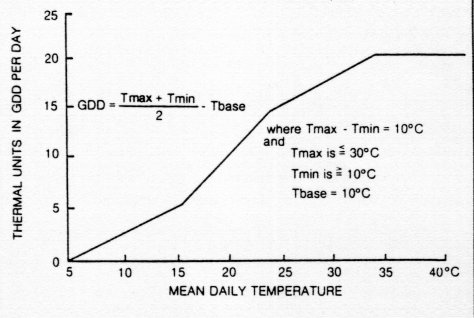
Growing degree days
2200 2600 3000 3400
Planted Date Days Date Days Date Days Date Days
-------------------------------------------------------------------------------------
5/1 9/1 123 10/1* 153 -- -- -- --
5/15 9/8 116 10/17* 155 -- -- -- --
Southern 5/29 9/19 113 -- -- -- -- -- --
Wisconsin 6/12 10/15* 125 -- -- -- -- -- --
6/26 -- -- -- -- -- -- -- --
4/19 8/9 112 8/25 128 9/14 148 10/16* 180
5/3 8/13 102 8/30 119 9/20 140 -- --
Central 5/17 8/20 95 9/7 113 10/5* 141 -- --
Illinois 5/31 8/30 92 9/20 112 -- -- -- --
6/14 9/14 92 10/16* 124 -- -- -- --
4/1 7/21 111 8/3 124 8/18 139 9/2 154
4/15 7/24 100 8/7 114 8/21 128 9/6 144
Southern 4/29 7/30 93 8/13 106 8/27 120 9/23 147
Illinois 5/13 8/6 85 8/22 101 9/5 115 10/7 147
5/27 8/16 81 8/31 96 9/18 115 11/6 --
------------------------------------------------------------------------------------
*Freeze risk greater than 50%
Comparisons of the response of a particular maturity class at different regions, or of a maturity class at different planting times within a region, can be made from the data. For example, because of cooler temperatures in the North, an early planting of May 1 in southern Wisconsin would need 123 days to accumulate 2200 GDD. Planting dates of May 15, 29, and June 12 would require 116,113, and 125 days to accumulate 2200 GDD values. In central Illinois a series of five plantings, two weeks apart, beginning when the average daily spring temperature first rises to 55 F (13 C) on April 19, would need 128, 119, 113, 112, and 124 days to accumulate 2600 GDD. For southern Illinois, the comparison would be 139,128,120,115, and 115 to accumulate 3000 GDD. When the days required for maturity begin to increase for June planting dates, it is rapidly becoming too late to plant the adapted hybrids for any given growing season heat zone of the Corn Belt. Blank cells in this table represent situations where there are not sufficient GDD for the maturity class to be adapted. Maturity dates indicated by an asterisk are situations of seasonal temperature patterns with very high freeze risks. Table 2 shows the effects of temperature changes within a growing season on the development of corn planted at different times.
The growing cycle of corn consists of vegetative, reproductive, and maturation phases, but there are more detailed stages of development within these phases. Different maturity classes require different GDD accumulations to reach these stages. The growing cycle and GDD requirement for different stages of a 2700 GDD hybrid are listed in Table 3.
Phase Development Stage Number GDD
--------------------------------------------------------------------------------
Planted 0 0
Two leaves fully emerged 0.5 200
Vegetative Four eaves fully emerged 1.0 345
Six leaves fully emerged 1.5 475
(Growing point above soil)
Eight leaves fully emerged 2.0 610
(Tassel beginning to develop)
Tenth leaves fully emerged 2.5 740
Twelve leaves fully emerged 3.0 870
(Ear formation)
Fourteen leaves fully emerged 3.5 1000
Reproductive (Silks developing on ear)
Sixteen leaves fully emerged 4.0 1135
(Tip of tassel emerging)
Silks emerging/pollen shedding 5.0 1400
(Plant at full height)
Kernels in blister stage 6.0 1660
Kernels in dough stage 7.0 1925
Kernels denting 8.0 2190
Maturation Kernels dented 9.0 2450
Physiological maturity 10.0 2700
---------------------------------------------------------------------------------
When seed is planted in moist soil, about 200 GDD above 50 F is required for a seed to germinate and the young seedling to become established. By this time, it has two functioning leaves and a root system so it is no longer dependent on the diminishing food supply that was stored in the seed. When corn is planted too early or when a season is cool, it takes too long to accumulate the needed 200 GDD. Consequently, the seedling becomes weak and vulnerable to soil fungus diseases, which then results in a poor stand.
When 475 GDD is accumulated, six leaves have formed and the growing point has risen above the soil surface. At 870 GDD, 12 leaves have formed and a small embryonic ear starts to develop within the plant tissue. It is at this time that the vegetative phase starts to cease and the reproductive stage begins. At 1400 GDD, all the leaves have developed, the tassel has emerged, and the plant has reached its full height; then the silks emerge from the ear and are receptive to the shedding pollen. Grainfill starts to cease, maturation begins, and some kernels become dented at 2190 GDD. At 2700 GDD, a black layer forms near the base of the kernel indicating that dry matter is no longer being translocated to the grain. The corn is at physiological maturity and safe from a freeze; however, the corn is still 35 to 40 percent moisture and will need to dry down before it can be stored.
When used over a large geographic area and over a range of planting times, the GDD system becomes more meaningful in understanding the response of corn to temperature. GDD's are also useful in predicting crop response at different planting dates or when seasonal temperatures deviate from average values.
Figure 5 shows the rates of development as measured by days from planting for different development phases of a 2700 GDD hybrid at eight planting dates, each ten days apart, beginning April 15 in central Illinois. These graphs are based on the GDD requirements in Table 3 and normal daily GDD accumulations for Decatur in central Illinois.
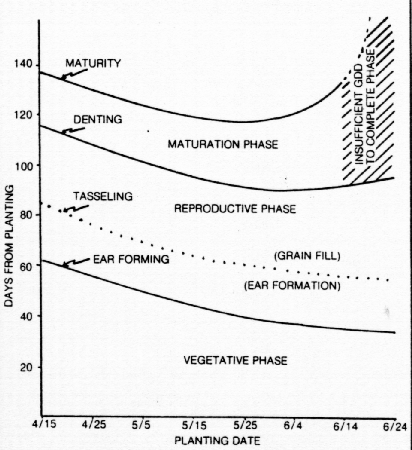
The temperature available for growth during different development phases varies with time of planting. Because of cooler temperature, early plantings have longer vegetative stages while later plantings require more time to accumulate the GDD necessary to mature grain. The reproductive phase, from ear formation to denting, is less affected by planting time. The variation in days to maturity at different planting times is largely the result of differences in the rates of maturity in the vegetative and maturation phases.
For example, as may be seen in Figure 5, corn planted on April 15 takes 136 days to accumulate 2700 GDD. Almost half of this time, 62 days, is in the vegetative stage. The corn is expected to tassel in 84 days, begin denting in 115 days, and because of warm temperature, require 136-115 = 21 days for grain maturation. A planting in mid-May is expected to accumulate 2700 GDD and be mature in 119 days. Because of warmer temperature at planting, the corn would be in the vegetative phase for 44 days. It would begin to dent 96 days after planting and would require 119-96 = 23 days for grain maturation. With still warmer temperatures at planting, corn planted on June 14 would be in the vegetative stage only 36 days. The grain would begin denting 91 days after planting. However, delays in planting shift maturation into the cooler part of autumn so that it takes a longer time to accumulate the necessary GDD for this phase of the cycle. The June 14 planting is expected to take 44 days for maturation. This increases the total time to maturity to 135 days. A June 24 planting would have sufficient GDD for the vegetative and reproductive phases, but unless the growing season is warmer than normal, would not accumulate sufficient GDD to complete the maturation phase.
With dryland farming, corn is generally not grown in areas receiving less than 25 inches (60 cm) of annual precipitation. For high yields 18 to 20 inches (45 to 50 cm), or more, moisture should be available during the growing season. This water requirement must be met by natural rainfall, stored soil moisture from precipitation prior to the growing season, or as is the case in the drier western part of the Corn Belt, from supplemental irrigation.
Annual precipitation decreases from over 40 inches (100 cm) in the East to less than 25 inches (60 cm) in the West, across the Corn Belt, see Figure 6. However, as shown in Table 4, the amount of rainfall during the five-month growing season, May through September, is relatively constant. It ranges between 17.51 to 19.39 inches for most of the Corn Belt but drops off rapidly in central Nebraska which is near the western limit for dryland corn. This constancy of rainfall across the Corn Belt is a very significant growing-season characteristic.
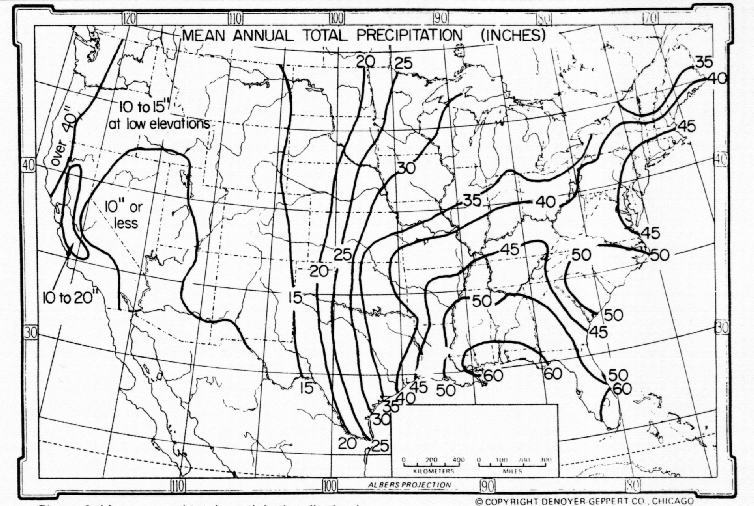
Central Central Central Eastern Central
Indiana Illinois Iowa Nebraska Nebraska
(Kokomo) (Peoria) (Des Moines) (Omaha) (North Platte)
------------------------------------------------------------------------------------
May-September 18.41 17.51 19.39 18.38 14.09
October-April 20.32 17.12 12.24 9.67 5.8
Annual 38.73 34.63 31.63 28.05 19.09
-----------------------------------------------------------------------------------
Preseason precipitation during October through April is important for recharging soil moisture between seasons. Many Corn Belt soils are able to store about 10 inches of moisture in the five-foot depth to which corn roots may extend. The amount of preseason fall and winter precipitation available for recharge decreases from 20.32 inches at central Indiana in the eastern part of the Corn Belt to 5.8 inches in central Nebraska in the west. Artificial tile drainage to remove surplus soil moisture prior to planting in the East and irrigation to replenish moisture deficit in the West represent major differences in water management practices across the region.
As a corn plant grows, its demand for water increases with increasing leaf area which reaches a maximum near the tasseling stage. The period of time shortly before pollination through grainfill, when the kernels begin to dent, is a critical period during which adequate moisture is important to corn yield. This period begins in mid-July and may extend into mid-August over most of the Corn Belt. Except for the Western part, where irrigation is necessary, most of the Corn Belt averages 3.0 to 3.5 inches (7.5 to 8.8 cm) of rainfall in July. This moisture, plus stored soil moisture, is sufficient to meet crop needs in most years.
The average annual solar radiation varies from about 300 langleys (gram calories per centimeter squared per minute) in the Northeast to over 500 langleys in the Southwest desert areas, as illustrated in Figure 7. The average for the Corn Belt ranges from 330 to 360 langleys. This figure is the energy that evaporates water from ponds and lakes, from the soil, and through plants. The annual evaporation measured from the network of pans, by the National Weather Service, relates rather closely to the average annual solar radiation values, see Figure 8. In the Northeast, pan evaporation averages less than 40 inches (100 cms), while in the Southwest, an average of over 100 inches (250 cms) of water may be evaporated each year.
From an average growing-season water-balance viewpoint, the increased solar energy in the western Corn Belt causes greater crop water use. Evaporation exceeds rainfall, so the seasonal water balance is, on the average, more negative in the Western areas. This greater crop water use is related to increases in solar radiation, temperature, and winds, which result in lower daily average humidity.
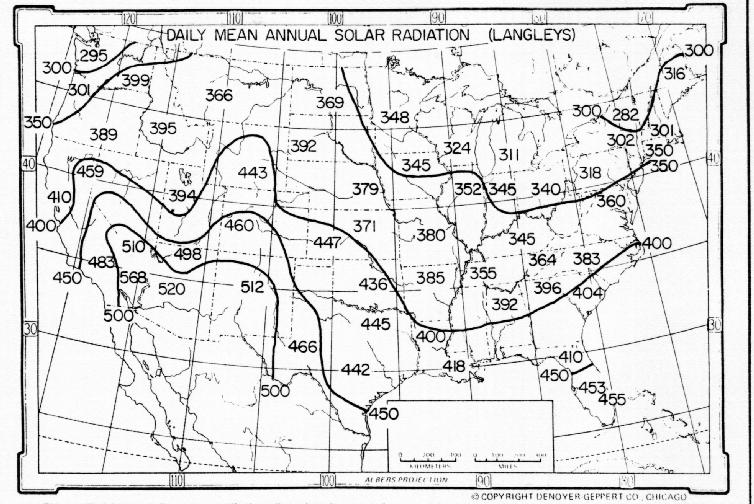
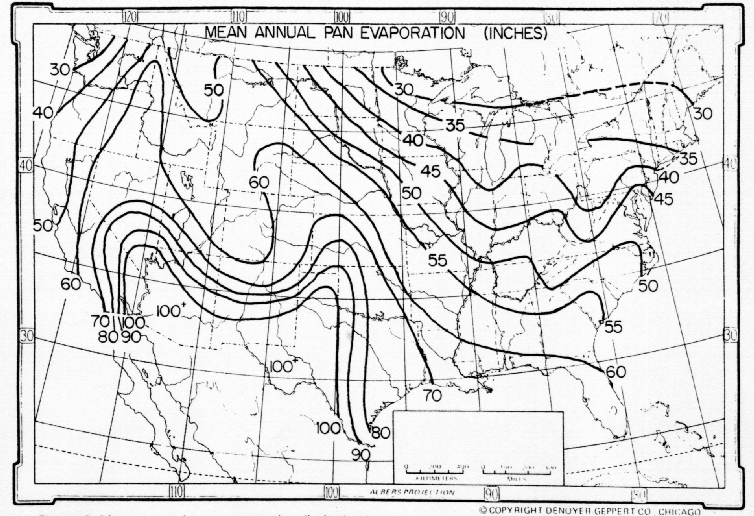
Another measure of potential negative crop water balance is related to average number of days with temperatures above 90 F (32 C) during the corn growing season. Figure 9 illustrates the average annual number of days with temperatures of 90 F and above. The western and southern areas of the United States average between 30 and 60 such days, while the northern and eastern portions average less than 20 days per year. Significant reductions in corn yields may occur in years when hot spells coincide with the critical ear formation, reproduction, and grainfill period.
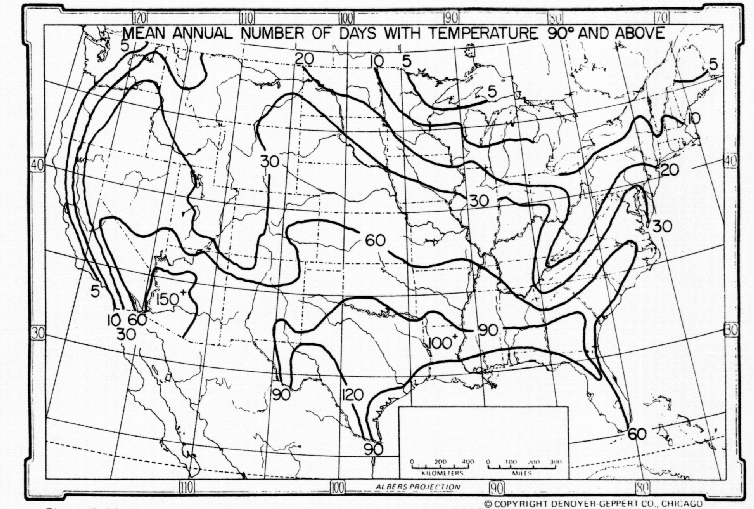
RR 4/90
Cooperative Extension Work in Agriculture and Home Economics, State of Indiana, Purdue University and U.S. Department of Agriculture Cooperating. H.A. Wadsworth, Director, West Lafayette, IN. Issued in furtherance of the Acts of May 8 and June 30, 1914. It is the policy of the Cooperative Extension Service of Purdue University that all persons shall have equal opportunity and access to our programs and facilities.